Summary of Findings
 As shoppers flock to the stores for holiday gifts, some express mixed feelings about the nation’s largest retailer. Nearly every American lives near enough a Wal-Mart to shop there, and 84% say they have done so in the past year. Praise for the retailer’s low prices, wide selection and convenience flow freely, and 81% of those with a Wal-Mart nearby say it is a good place to shop.
As shoppers flock to the stores for holiday gifts, some express mixed feelings about the nation’s largest retailer. Nearly every American lives near enough a Wal-Mart to shop there, and 84% say they have done so in the past year. Praise for the retailer’s low prices, wide selection and convenience flow freely, and 81% of those with a Wal-Mart nearby say it is a good place to shop.
Somewhat less glowing, however, are judgments about Wal-Mart’s effect on communities and the nation as a whole, and a third of the public (34%) rates it a bad place to work. Overall, 69% of those familiar with Wal-Mart have a favorable opinion of the company. Still, 31% have an unfavorable view, which is a considerably higher negative rating than is accorded to many other major corporations.
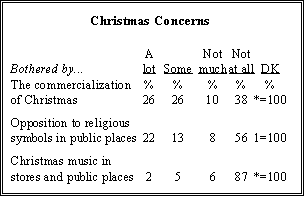 Whatever their feelings about Wal-Mart and other major retailers, the public is largely unconcerned about how they are greeted as they enter stores and businesses this season. By a substantial 60%-23% margin the public does prefer “Merry Christmas” to non-religious welcomes such as “Season’s Greetings.” But given the choice, a 45% plurality says it does not matter much either way. A great majority of Americans (83%) say displays of Christmas symbols should be allowed in public places. But fewer than half (44%) approve of Christmas symbols being displayed alone, without Hanukkah, Kwanzaa and other holiday symbols.
Whatever their feelings about Wal-Mart and other major retailers, the public is largely unconcerned about how they are greeted as they enter stores and businesses this season. By a substantial 60%-23% margin the public does prefer “Merry Christmas” to non-religious welcomes such as “Season’s Greetings.” But given the choice, a 45% plurality says it does not matter much either way. A great majority of Americans (83%) say displays of Christmas symbols should be allowed in public places. But fewer than half (44%) approve of Christmas symbols being displayed alone, without Hanukkah, Kwanzaa and other holiday symbols.
 The latest national survey by the Pew Research Center for the People & the Press, conducted Dec. 7-11 among 1,502 adults, finds that more Americans are bothered at least some by the commercialization of Christmas (52%) than by opposition to the display of religious symbols in public places (35%). Indeed, a solid majority (56%) says they are not bothered at all by such opposition to religious displays.
The latest national survey by the Pew Research Center for the People & the Press, conducted Dec. 7-11 among 1,502 adults, finds that more Americans are bothered at least some by the commercialization of Christmas (52%) than by opposition to the display of religious symbols in public places (35%). Indeed, a solid majority (56%) says they are not bothered at all by such opposition to religious displays.
The survey finds that the public has overwhelmingly positive feelings toward some corporate giants with health care product maker Johnson & Johnson, internet search engine Google, and Home Depot held in nearly universal good esteem by Americans familiar enough with the firms to rate them.
Wal-Mart’s favorable rating of 69% places it just below McDonald’s (74%) and General Motors (74%), and somewhat above pharmaceutical maker Pfizer (61%), although a substantial number of people (36%) said they had never heard of Pfizer or couldn’t judge it.
Fewer than half of Americans (47%) who were able to rate Exxon Mobil have a favorable opinion of the oil major. And just 41% have a positive view of Halliburton, the energy services company that has been the focus of allegations of impropriety in its handling of government contracts. Halliburton, however, is not widely recognized; 44% were unable to rate the company.
 “Merry Christmas” vs. “Happy Holidays”
“Merry Christmas” vs. “Happy Holidays”
When asked to choose between “Merry Christmas” and non-religious terms, most Americans (60%) say they prefer that stores and businesses greet customers by saying “Merry Christmas.” Only one-in-four (23%) prefers the use of terms such as “Happy Holidays” and “Season’s Greetings,” while 17% volunteer that they do not care which greeting is used.
But given the specific option of saying the choice of greeting really does not matter, a plurality does so. Asked a slightly different version of the question that, along with the two choices of preferred greeting, offers the alternative “or doesn’t it matter to you?,” 45% choose this last alternative. Only 42% say they prefer “Merry Christmas,” while 12% prefer less religious terminology.
Most striking is the age difference in preferences for holiday greetings. Only among those ages 65 and over, does a majority (64%) opt for “Merry Christmas.”
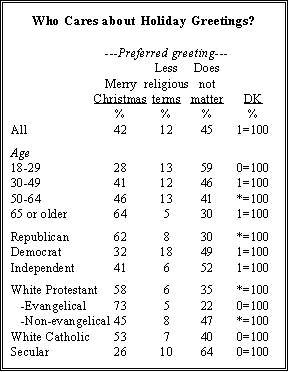 That preference declines across younger age groups with only 28% of those under age 30 opting for the Christmas greeting while roughly six-in-ten say the choice of greeting doesn’t matter to them.
That preference declines across younger age groups with only 28% of those under age 30 opting for the Christmas greeting while roughly six-in-ten say the choice of greeting doesn’t matter to them.
Several other groups stand out for their strong preference for the Christmas greeting. Even when explicitly offered the opportunity to say this issue doesn’t matter, majorities of white evangelical Protestants (73%) and Catholics (53%) say they prefer “Merry Christmas.” By contrast, a majority (64%) of seculars and nearly half (47%) of white mainline Protestants say this issue does not matter to them. Similarly, while more than six-in-ten Republicans prefer to be greeted with “Merry Christmas,” nearly half (49%) of Democrats and a small majority (52%) of independents are unconcerned by stores’ choice of holiday greetings.
Christmas Displays on Public Property
Americans overwhelmingly support allowing public Christmas displays at least if they are part of a display that includes symbols of other faiths and holiday traditions. More than eight-in-ten (83%) say that displays of Christmas symbols such as nativity scenes and Christmas trees should be allowed on government property, while 11% say that such displays should not be allowed.
There is less support, however, if Christmas symbols are displayed alone on public property: Fewer than half (44%) of Americans say such Christmas-only displays should be allowed, while 27% say that Christmas symbols should only be allowed if Hanukkah, Kwanzaa, and other symbols are also displayed, and 12% say it does not matter or express no opinion.
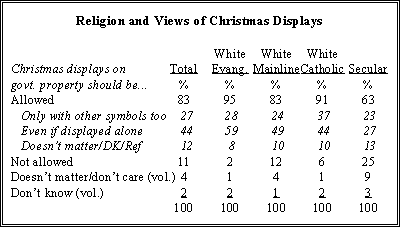 White evangelical Protestants are nearly unanimous in their support of public Christmas displays, with 95% saying Christmas symbols should be allowed on government property. Furthermore, a large majority (59%) of evangelicals would allow such displays even if Christmas symbols are unaccompanied by symbols of other traditions.
White evangelical Protestants are nearly unanimous in their support of public Christmas displays, with 95% saying Christmas symbols should be allowed on government property. Furthermore, a large majority (59%) of evangelicals would allow such displays even if Christmas symbols are unaccompanied by symbols of other traditions.
White mainline Protestants (83%) and Catholics (91%) also overwhelmingly support allowing Christmas displays, though fewer among these groups (49% of mainline Protestants and 44% of Catholics) support displaying Christmas symbols in isolation. More than six-in-ten seculars (63%) are comfortable with public Christmas displays, although only one-in-four (27%) says they are acceptable if displayed alone.
 There is also a partisan dimension to opinions on this issue. Though large majorities of Republicans (90%), Democrats (78%) and independents (84%) all favor allowing Christmas displays on government property, Republicans are the only group among whom a majority (56%) supports Christmas displays in isolation. Far fewer Democrats (37%) and independents (45%) embrace the idea of allowing public Christmas displays without displaying symbols from other traditions as well.
There is also a partisan dimension to opinions on this issue. Though large majorities of Republicans (90%), Democrats (78%) and independents (84%) all favor allowing Christmas displays on government property, Republicans are the only group among whom a majority (56%) supports Christmas displays in isolation. Far fewer Democrats (37%) and independents (45%) embrace the idea of allowing public Christmas displays without displaying symbols from other traditions as well.
Holiday Concerns
Despite their support for allowing Christmas displays on government property and media attention to the controversies over such displays, most Americans are unconcerned by opposition to religious symbols in public places. Indeed, far more Americans say they are bothered at least to some extent by the commercialization of Christmas (52%) than say they are bothered by opposition to religious symbols in public places (35%).
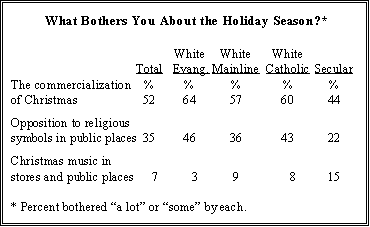 Across the religious and political spectrum, opposition to religious symbols in public places bothers fewer people than does the commercialization of Christmas. Even among white evangelical Protestants and Republicans, only about one-in-three (34% of evangelicals and 32% of Republicans) say that opposition to religious symbols bothers them a lot.
Across the religious and political spectrum, opposition to religious symbols in public places bothers fewer people than does the commercialization of Christmas. Even among white evangelical Protestants and Republicans, only about one-in-three (34% of evangelicals and 32% of Republicans) say that opposition to religious symbols bothers them a lot.
Concern about the commercialization of Christmas is most pronounced among evangelical Protestants (64% of whom are bothered by it), followed by Catholics (60%) and mainline Protestants (57%). More than four-in-ten seculars
(44%) find Christmas commercialization bothersome.
Wal-Mart Nation
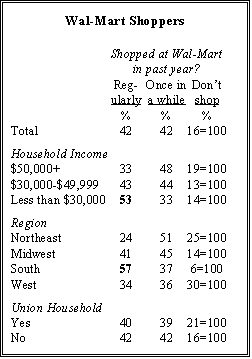 Among a list of 15 major U.S. corporations, Wal-Mart scores as the most recognizable: Just 5% of Americans say they have never heard of it or are unable to rate it. That high visibility is hardly surprising given that, when asked in a separate question, 91% of the public said that there is a Wal-Mart near enough to where they live that they could shop there if they wanted to.
Among a list of 15 major U.S. corporations, Wal-Mart scores as the most recognizable: Just 5% of Americans say they have never heard of it or are unable to rate it. That high visibility is hardly surprising given that, when asked in a separate question, 91% of the public said that there is a Wal-Mart near enough to where they live that they could shop there if they wanted to.
And most people do want to: Fully 84% of Americans say they have shopped at a Wal-Mart store in the past 12 months and half of these (42% of the total) say they have done so regularly.
Wal-Mart’s most faithful shoppers are found among those with annual incomes below $30,000, more than half of whom (53%) say they shop there regularly. But about a third (33%) of those with incomes above $50,000 are also frequent buyers at the stores and nearly another half (48%) are sometime customers.
Regionally, the South holds a strong lead in Wal-Mart patronage, with 57% of its residents saying they shop there regularly. Fewer Midwesterners (41%), and Westerners (34%), and a mere 24% of those in the Northeast are regular Wal-Mart shoppers. Despite strong criticism of the retail giant by labor unions, there is no significant difference between union and non-union members in their propensity to shop at Wal-Mart.
 Wal-Mart’s Positives and Negatives
Wal-Mart’s Positives and Negatives
When asked to name what they like best about Wal-Mart, most refer to the stores and the services they offer rather than to the corporation itself. Low prices top the list, accounting for 50% of the words of praise while other aspects of shopping, such as broad selections and convenience accounted for another 32%. Only 6% mention good things about the company including its creation of jobs and its employment policies.
By contrast, criticisms of Wal-Mart are more often directed at the company’s practices (39%) especially its wages, benefits and employment policies than at individual stores and the quality of products (32%). At the service level, long lines and poor customer service top the list of what people dislike about the stores.
Rating Wal-Mart
Solid majorities feel Wal-Mart is a good place for their family to shop, and is good for their community and the country. Where Wal-Mart receives its lowest but still positive net ratings, is on the question of whether, based on what they have seen or heard, people feel the company is a good place to work. On this question a small majority (56%) rates it good compared with 34% who say it is a bad place to work.
People living in households with modest incomes (less than $30,000 a year) give Wal-Mart its highest marks in every dimension, though significantly fewer say the retailer is good for the country (68%) or as a place to work (62%) than say it is good for shopping (87%) or for their community (78%).
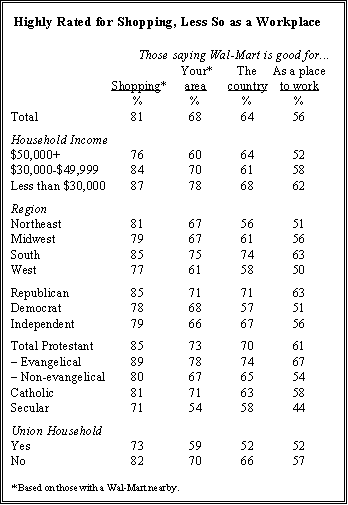 Among geographical regions, the South is home to Wal-Mart’s strongest fans though even in this region the retailer earns its lowest mark (63%) as an employer. In the Northeast and West only half the public calls Wal-Mart a good place to work.
Among geographical regions, the South is home to Wal-Mart’s strongest fans though even in this region the retailer earns its lowest mark (63%) as an employer. In the Northeast and West only half the public calls Wal-Mart a good place to work.
Republicans are most likely to judge the store good for shopping, for communities, for the country and for workers. Democrats and independents share their assessments of Wal-Mart as good places to shop and good for their communities, but Democrats are more dubious about the firm’s effect on the country (only 57% rate it good) and especially on workers, with only a bare majority (51%) calling Wal-Mart a good place to work.
Overall, persons in households with a union member are less likely to give Wal-Mart the OK, though at least a small majority rates the firm “good” in every category.
Rating Big Business
In general, the public’s opinion of major U.S. corporations rose as the year neared its end. As recently as October, only 45% of the public expressed a very or mostly favorable view of companies; in December, 57% did so, although only 9% expressed a very favorable opinion.
 But business is still a long way from the 73% approval it enjoyed in 1999 when the economy was still booming and before the recent rash of corporate scandals hit the headlines.
But business is still a long way from the 73% approval it enjoyed in 1999 when the economy was still booming and before the recent rash of corporate scandals hit the headlines.
Despite its improved image, business is still the target of concern among an equally large number of Americans who feel that corporations make too much profit. More than six-in-ten (61%) hold this view (and 52% do so strongly), a significant increase over the 53% who did so a year earlier.


